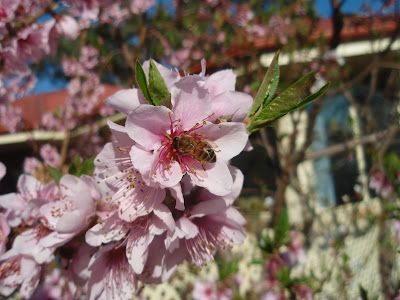Especially colourful this year are a few wattles that seeded in the mulch around the vegie garden and were subsequently potted and planted into the garden. Seeds from a tree that hangs over the fence make the most of conditions in my garden and dozens of tiny trees come up every year. Mostly I pull them up, treating them as weeds because I don't have space to plant many, but I'm glad I have found room for three of them to grow. It did seem a waste not to use more of them. Then I thought of an old friend who lives on a farm out of town. She does have space, lots of space. Now many of the seedlings are dug up and sent to a new home. As well, last year some mysterious little plants grew in a pot of soil that I'd left in the vegie garden. When they had developed a little, I identified them as callistemons, also from a tree next door. They too have found a new home on the farm.
The other day my friend brought me a beautiful bunch of camellias from an old tree on the farm. Life would be less colourful, less interesting, without our old friends.
















